| |
Genus: Earthstar
Genus: (Geastrum)
Earthstars seem to be difficut to recognise. There is a lot of variation within species.
There growing phases with a lot of resemblance. And there are aberrations.
All earthstars of genus Geastrum have:
- Balloon
- Rays (slips), star-rays
- Pseudo-stem (columella, often invisible) from the attachement to the ground upto inside the balloon between the spores.
A balloon has:
- Skin-thickness: paper-thin to leather-thick
- Skin-surface: bold, floury, cristalline, woolly-fibrous or rough-warty
- Mouth: Mouth-zone (i.e. peristome) with or without arounding clearly limited court (ring-furrow)
Star-rays may have:
- Species specific hygroscopic tendency to curl or stretch, and curling again under wet circumstances
- Species specific subhygroscopic tendency to curl or stretch only once in a life-time
- Species specific non-hygroscopic tendency to neither curl nor stretch
- Species specific surface on top and at the bottom: bald or rough, and color changable or not color changable
- Species specific bottom with or without encrusted debris (i.e. soil and litter, fixed by hyphes)
- Species specific bottom without or with a scar.
Species with a scar are basimyceliate species. Unopened, they are only connected to the basis of the fruit-body; after spreading the earth-rays the fruit-body
is no longer fixed to the ground and the fixation-point is broken, forming a scar. These species start with an onion-shaped or tulip-shaped body.
Species without a scar are perimyceliate species. Their unopend fruit-bodies are globose-shaped and partially under ground, surrounded by hyphes.
Upon opening and spreading the star-rays, nothing is broken. The hyphes still keep connected with the bottom of the star-rays.
Most of the perimyceliate species have encrusted debris.
Star-rays-tips usually keep the longest connection with the hyphes. The star-rays-shape often is formed by the effect of partial fixation.
|
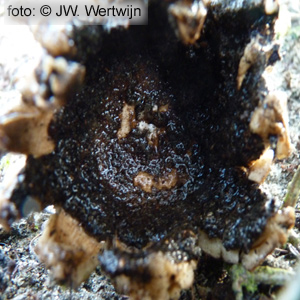
Encrusted debris
|
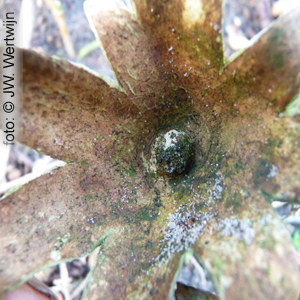
Scar
|
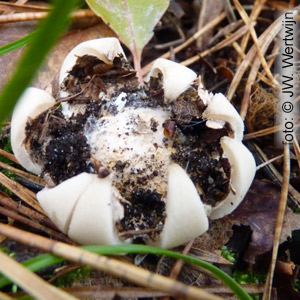
Encrusted debris
|
Not all species of genus Geastrum visible have:
- Pseudo-stem: the stem under the balloon is visble or unvisible. (If visible, than the bottom of the balloon and the stem together form some kind of plica).
If the stem is visible, the visibility is growing phase dependent. Tip: use the top of a pizza oven, and dry them at about 50 degrees Celsius; after a day or
so the stem becomes visible (apophyse as well if you are trying it with the right kind, of course).
- If there will be a visible stem later, there might be a meaty cylinder (manchet) between the star-rays and the bottom of the balloon.
The visibility of the cylinder is growing phase dependent.
- Apophyse (plica) at the bottom of the balloon. If some species do have this property,
than the visibility of it is growing phase dependent. Three shape types in Holland: rounded bag-shape, sleeve-shape and funnel-shape.
- Collar: a collar is a broken upper-surface of the star-rays (pseudoparenchymatous layer),
forming a plate under the balloon. A collar is hardly shrinking; only in the coastal dunes under extreme conditions
and late in the season a collar can be shrunken. And in that case Collared Earthstar may have look-alikes. Under such circumstances the species can be recognized
by looking at the bottom of the star-rays.
Species that might develop a Collar between Star-rays and balloon like Collared Earthstar,
Felty Earthstar (Geastrum saccatum), and
Crowned Earthstar (Geastrum coronatum) develop that collarish shape growing phase dependent.
- Injuring color changes only occur for Rosy Earthstar (Geastrum rufescens).
If you scratch it, it changes reddish.
But be aware, there are other species changing color all by theirselves into some kind of rosy color like
Collared Earthstar (Geastrum triplex),
Crowned Earthstar (Geastrum coronatum),
Sessile Earthstar (Geastrum fimbriatum), and
Beaked Earthstar (Geastrum pectinatum)
|
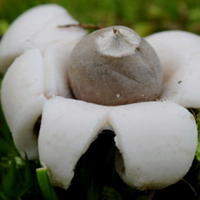
Star-rays Saccate
|
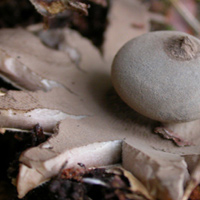
Star-rays Convex
|
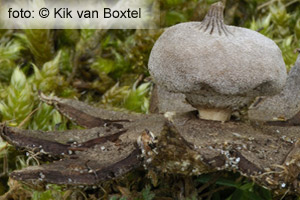
Star-rays Convex |
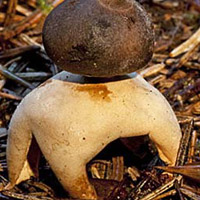
Star-rays Fornicate
|
|
Rays curling sometimes is specific for certain species, but it is merely growing phase dependent:
|
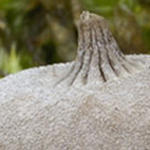
Plicate, furrowy, conic |
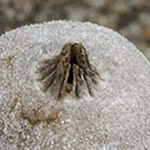
Plicate, low conic |
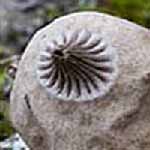
Plicate, clear court |
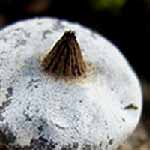
Plicate, furrowy |
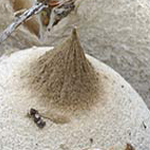
Conic (pre-plicate) |
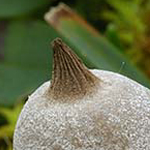
Plicate, conic |
Mouth-zone is species distinctive, and is growing phase dependent:
- Plicate-furrowy (pectinate): around the mouth-zone there are three or more radiate plica; like:
Field Earthstar
- fibrillose (fimbriate): around the mouth-zone there are neigher furrows nor plica,
but most species do have some radiate baldy fibres around their mouth; like
Sessile Earthstar.
Most species, so at least there is one exeption. fibrillose without radiate baldy fibres:
Rosy aardster
- Low conic: mouth-zone is less high than wide, like sometimes
Field Earthstar
- Conic: mouth-zone is as high as wide, or higher than wide, like
Elegant Earthstar, and sometimes
Field Earthstar
- Clear court: the court and/or ring-furrow form a sharp contrast between mouth-zone and the rest of the balloon, like
Dwarf Earthstar
- Unlimited: no court (with colorish and/or structural difference in the mouth-zone), no ringfurrow, like
Rosy aardster
|
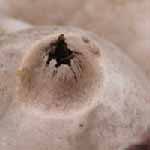
fibrillose |
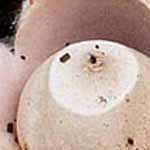
fibrillose, light court |
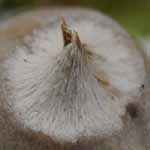
fibrillose, light court |
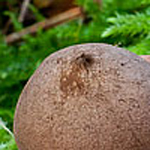
fibrillose, unlimited |
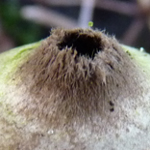
fibrillose |
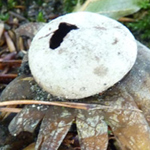
Tear, no mouth-zone |
Apophyse (plica)
The apophyse is the plica under the balloon.
The apophyse only exists for those species with a visible stem at maturation. There are three shapes:
Rounded bag-shaped, Sleeve-shaped and Funnel-shaped. It depends on the matter of maturing if they look like this:
|
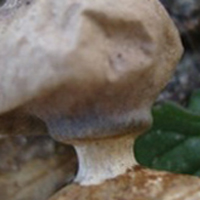
Rounded bag-shaped
|
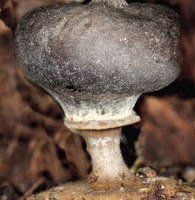
Sleeve-shaped
|
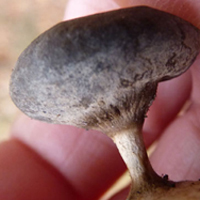
Funnel-shaped
|
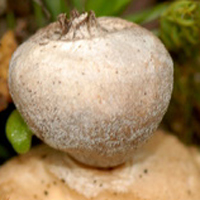
Rounded bag-shaped
|
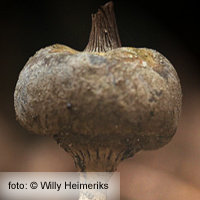
Funnel-shaped, plicate,
furrowy, high conical
|
Photographer Tips:
(wise out of experience)
- Make a picture of the whole earthstar from right up, focus at the mouth-zone
- Make a picture of right aside (en face). Focus at the apofyse just below the balloon
- Put the earthstar up side down, and focus at the eventually encrusted debris between the star-rays
- Remove the mycelium below de wreath of rays, and make a picture of the bottom, focus at the eventually available scar
- Turn the earthstar back to normal, so the next passing nature lover can enjoy the untouched fungi world
|
|
Tips for growing phase dependent pictures:
There are 20 Geastrum species in the Netherlands. Only at maturity all twenty are completely different.
In a lot of stages they have more in common, then there have differences. One picture is not enough, then.
It is funny to collect pictures of all phases together. But then an area is needed with only one of a limited number of species.
In the Northsea dunal coast there are too many species to learn one at the time. More inland it is easier to find places with only one or two species.
Soil and landscape is determining species habitats.
Regional:
In and near Amsterdam in the last centuries these Earthstars have been found:
In the pleistocene area these species were found:
All (other) species can be found along the Northsea dunal coast.
Literature:
Chrispijn, R. ed. (1999), Champignons in de Jordaan (De paddenstoelen van Amsterdam), Schuyt en Co, 162-163.
Hansen L. & H. Knudsen (1997), Nordic Macromycetes, Vol. 3, Heterobasidioid, aphyllophoroid and gasteromycetoid basidiomycetes, Kopenhagen, 1997, 444 pp.
Jalink, Leo M (1995) De aardsterren van Nederland en België, Coolia 38 Supplement.
Pegler, e.o. (1995), British puffballs, earthstars and stinkhorns, an account of the british gasteroid fungi, Royal Botanic Gardens, kew, 1995, 255 pp.
www.mycobank.com
|
Source: Earthstar files at http://werthof.home.xs4all.nl/paddenstoelen/stomach_fungi.html
Top
|